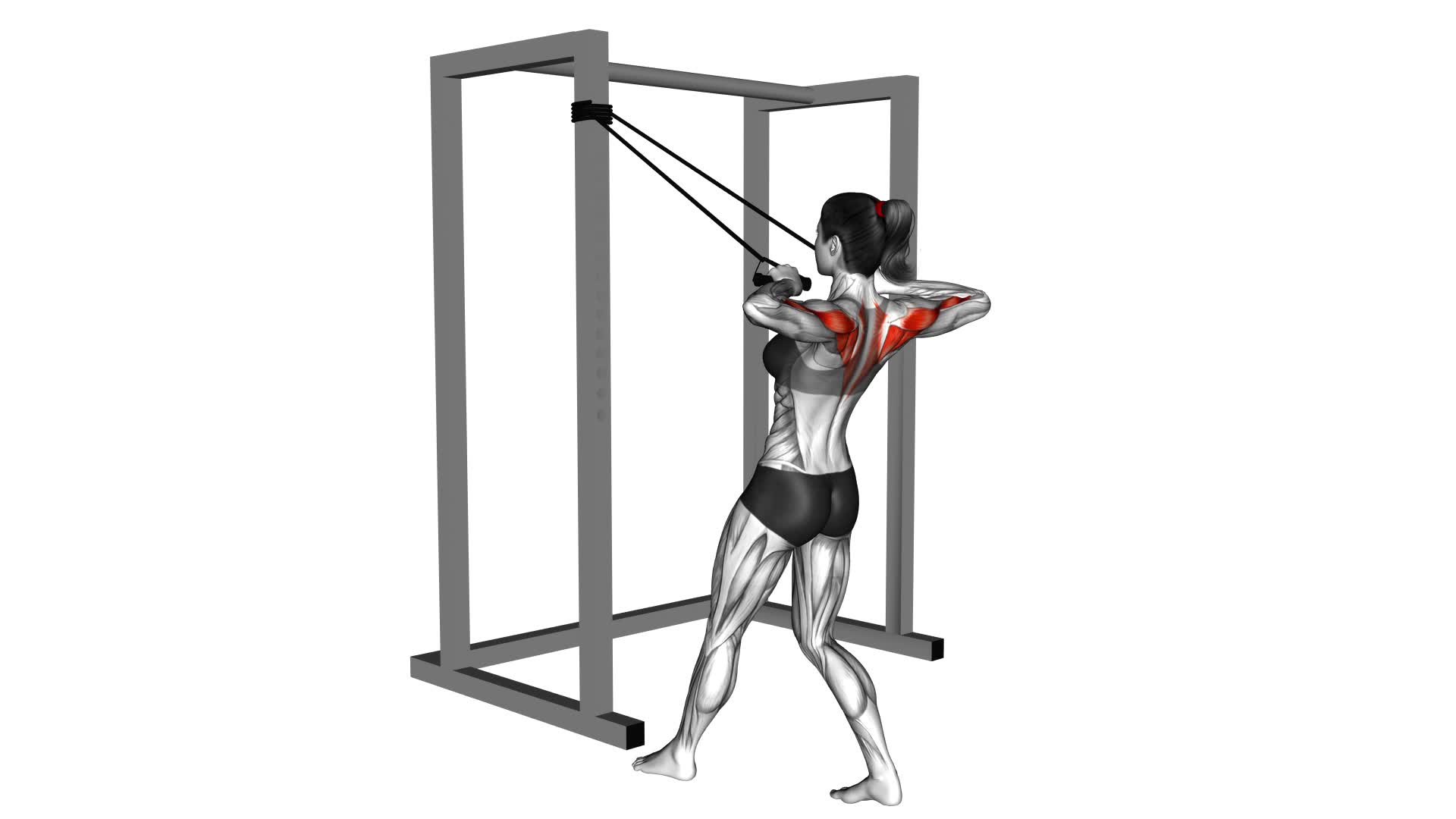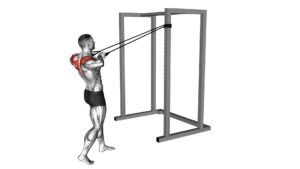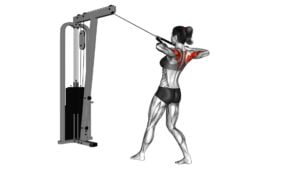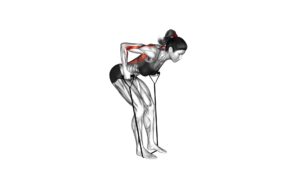Band Standing Rear Delt Row (Female) – Video Exercise Guide & Tips

Looking to strengthen your rear deltoids? The band standing rear delt row is the perfect exercise for you.
Watch This Exercise Video
This video exercise guide and tips will show you how to properly perform this exercise, ensuring maximum results.
All you need is a resistance band to get started.
Avoid common mistakes and learn variations and modifications to challenge yourself.
Get ready to tone and strengthen your upper body with this effective exercise.
Key Takeaways
- Targets the muscles of the shoulders and upper back
- Improves shoulder strength and posture
- Strengthens rear deltoids for proper posture and preventing rounded shoulders
- Alleviates shoulder pain
Benefits of the Band Standing Rear Delt Row
Discover the benefits of the Band Standing Rear Delt Row for a stronger and more sculpted upper body. This exercise is highly effective in targeting the muscles of the shoulders and upper back, helping to improve shoulder strength and posture.
By incorporating the Band Standing Rear Delt Row into your workout routine, you can strengthen the muscles responsible for shoulder stability and mobility. This exercise specifically targets the rear deltoids, which play a crucial role in maintaining proper posture and preventing rounded shoulders. Strengthening these muscles can help alleviate shoulder pain and improve overall posture.
Additionally, the Band Standing Rear Delt Row engages the muscles of the upper back, including the rhomboids and trapezius, further enhancing back strength and stability. By performing this exercise regularly, you can develop a well-rounded upper body and achieve a more balanced physique.
To maximize the benefits of the Band Standing Rear Delt Row, it's important to use the appropriate equipment.
Equipment Needed for the Exercise
To properly perform the Band Standing Rear Delt Row, you'll need a resistance band and a sturdy anchor point, such as a door or pole.
The resistance band should be appropriate for your strength level, providing enough tension to challenge your muscles but still allowing for proper form.
In the video guide, you'll see a demonstration of the exercise using the recommended equipment, ensuring that you can follow along and perform the exercise correctly.
Essential Exercise Equipment
To perform the Band Standing Rear Delt Row exercise, you'll need specific exercise equipment. This exercise targets the muscles in the shoulders and upper back, helping to improve posture and strengthen the upper body.
The essential exercise equipment required for this exercise includes resistance bands and a sturdy anchor point, such as a door frame or a wall-mounted anchor. The resistance bands provide the necessary resistance to challenge and strengthen the muscles. It's important to choose a resistance band with appropriate tension to match your current fitness level.
Additionally, exercise variations can be incorporated by using different types of resistance bands, such as loop bands or tube bands, to target the rear deltoids from different angles.
Remember to always use proper form and consult a fitness professional before attempting new exercises.
Proper Form Demonstration
To properly perform the Band Standing Rear Delt Row exercise, you'll need specific exercise equipment. Here are four items you'll need:
- Resistance band: This elastic band provides the necessary tension for your rear delt muscles during the exercise.
- Door anchor: This attachment allows you to secure the resistance band to a door, providing a stable anchor point.
- Handles: These attachments can be added to the resistance band to provide a comfortable grip and better control during the exercise.
- Exercise mat: This provides a cushioned surface for you to stand on and helps prevent slipping during the exercise.
Different grips can be used with the handles to target various areas of your rear deltoids. It's important to maintain proper form and technique to ensure optimal muscle activation and prevent injury.
Proper Form and Technique
Start by positioning yourself in a standing position with your feet shoulder-width apart and a resistance band securely anchored at waist height. To ensure proper form and technique during the Band Standing Rear Delt Row exercise, it's important to avoid common mistakes and focus on maximizing results.
Firstly, make sure to maintain a neutral spine throughout the movement. Avoid rounding or arching your back, as this can lead to injury. Keep your core engaged and your shoulders pulled back and down.
Next, focus on the movement of your arms. As you pull the resistance band towards your chest, squeeze your shoulder blades together and engage your rear deltoid muscles. Be mindful of not using momentum or jerking the band, as this can reduce the effectiveness of the exercise.
Additionally, keep your elbows pointed out to the sides as you row, rather than letting them flare forward. This will help target the rear delts more effectively.
Remember to breathe consistently throughout the exercise, exhaling as you pull the band towards your chest and inhaling as you release. This will help maintain stability and control.
By following these proper form and technique tips, you can maximize the results of the Band Standing Rear Delt Row.
Now, let's move on to the next section to explore variations and modifications of this exercise.
Variations and Modifications
Now let's explore some different exercise options and how you can personalize them to meet your individual needs.
By incorporating variations and modifications into your routine, you can target different areas of your rear deltoids and challenge your muscles in new ways.
Whether you choose to use different resistance bands, adjust your grip, or change the angle of your body, these modifications can help you tailor the exercise to your fitness level and goals.
Different Exercise Options
Explore various exercise options for the Band Standing Rear Delt Row to target different muscle groups and achieve a personalized workout.
Here are four exercise variations that you can incorporate into your routine:
- Single Arm Band Standing Rear Delt Row: Hold the band with one hand instead of both, allowing you to focus on each side of your upper back independently. This variation helps improve muscle symmetry and balance.
- Wide Grip Band Standing Rear Delt Row: Widen your grip on the band to increase the activation of your upper back muscles, specifically targeting the rear deltoids. This variation enhances shoulder stability and strengthens the posterior chain.
- Seated Band Standing Rear Delt Row: Sit on a bench or chair while performing the exercise to isolate and engage your back muscles even further. This modification is an excellent option for those with lower back issues or a preference for seated exercises.
- Band Standing Rear Delt Row with Resistance: Increase the resistance of the band by using a thicker band or adding additional bands to challenge your muscles further. This variation is suitable for individuals who've progressed in strength and want to continue challenging their muscles.
Personalizing for Individual Needs
How can you customize the Band Standing Rear Delt Row exercise to meet your individual needs?
Personalizing this exercise is important to ensure that it aligns with your specific goals and capabilities. One way to customize it's by adjusting the resistance band's tension. If you find it too easy, use a stronger band; if it's too difficult, opt for a lighter one.
Another modification is to vary the grip width. A wider grip targets the rear delts more, while a narrower grip engages the upper back muscles.
Additionally, incorporating different rep ranges and tempos can help personalize the exercise further.
Common Mistakes to Avoid
To avoid common mistakes while performing the Band Standing Rear Delt Row exercise, make sure that you don't let your shoulders hunch forward. Proper technique is essential for maximizing the effectiveness of this exercise and preventing injury. Here are four common mistakes to avoid:
- Rounding your shoulders: Keep your shoulders pulled back and down throughout the entire movement. This helps engage the targeted muscles and prevents unnecessary strain on your neck and upper back.
- Using too much weight: It's important to start with a weight that allows you to maintain proper form. Using too much weight can lead to improper technique and increase the risk of injury.
- Not engaging your core: To maintain stability and support your back, engage your core muscles throughout the exercise. This helps protect your spine and enhances the effectiveness of the movement.
- Pulling with your arms instead of your back: Remember that this exercise targets your rear deltoids. Focus on pulling through your elbows while keeping your arms straight. This ensures that your back muscles are doing the work, rather than relying on your arms.
Tips for Maximizing Results
To maximize your results, focus on maintaining proper form and gradually increasing the resistance for the Band Standing Rear Delt Row exercise. This will ensure that you're effectively targeting your rear deltoid muscles and maximizing the intensity of your workout.
First and foremost, it's crucial to maintain proper form throughout the exercise. Stand with your feet shoulder-width apart, knees slightly bent, and back straight. Keep your core engaged and your shoulders relaxed. As you perform the exercise, focus on squeezing your shoulder blades together and pulling the resistance band towards your body while keeping your elbows in line with your shoulders. Avoid using momentum or swinging your body to complete the movement.
Additionally, to maximize the intensity of the exercise, gradually increase the resistance of the band as you become stronger. This can be done by using a band with higher tension or by doubling up on the band for added resistance. By challenging your muscles with progressively heavier resistance, you'll stimulate growth and achieve better results.
Frequently Asked Questions
How Many Sets and Reps Should I Do for the Band Standing Rear Delt Row Exercise?
To determine the number of sets and reps for the band standing rear delt row exercise, it's important to consider your fitness level and goals.
Start with 3-4 sets of 8-12 reps, using a resistance band that challenges your muscles but allows you to maintain proper form.
As you progress, you can increase the number of sets, reps, or resistance to continue challenging your muscles.
Remember to listen to your body and adjust accordingly to avoid overexertion.
Can I Use Dumbbells or a Cable Machine Instead of Resistance Bands for This Exercise?
Yes, you have alternative equipment options for the Band Standing Rear Delt Row exercise. Instead of resistance bands, you can use dumbbells or a cable machine.
Make sure to maintain proper form and technique throughout the exercise, regardless of the equipment you choose. This includes standing with your feet shoulder-width apart, keeping your back straight, and pulling your elbows back while squeezing your shoulder blades together.
Remember to start with a weight that challenges you but allows for proper execution.
Is This Exercise Suitable for Beginners or Should It Only Be Performed by Experienced Individuals?
This exercise is suitable for beginners and can be modified to accommodate different fitness levels. It targets the rear deltoids and upper back muscles.
To make it beginner-friendly, start with lighter resistance bands or lower weights. As you gain strength and confidence, gradually increase the resistance or weight.
Remember to maintain proper form and engage your core throughout the movement. Seek guidance from a qualified fitness professional if needed.
Can I Do the Band Standing Rear Delt Row Exercise if I Have Shoulder or Back Injuries?
If you have shoulder or back injuries, it may be best to avoid the band standing rear delt row exercise. Instead, consider alternative exercises that are less strenuous on these areas.
It's important to prioritize your safety and avoid aggravating any existing injuries. Consult with a qualified fitness professional who can provide modifications specifically tailored to your needs.
How Long Should I Rest Between Sets When Performing the Band Standing Rear Delt Row Exercise?
When performing the Band Standing Rear Delt Row exercise, it's important to consider the rest periods between sets. Rest periods allow your muscles to recover and prepare for the next set.
The duration of rest periods can vary depending on your fitness level and goals. Generally, a rest period of 30-90 seconds is recommended for this exercise. However, it's always a good idea to listen to your body and adjust the rest periods accordingly.
Conclusion
In conclusion, the band standing rear delt row is a beneficial exercise for targeting the rear deltoid muscles.
It requires minimal equipment and can be easily modified for different fitness levels.
By maintaining proper form and avoiding common mistakes, individuals can maximize their results and improve their upper body strength.
Incorporating this exercise into a regular workout routine can help individuals achieve their fitness goals effectively.

Author
Years ago, the spark of my life’s passion ignited in my mind the moment I stepped into the local gym for the first time. The inaugural bead of perspiration, the initial endeavor, the very first surge of endorphins, and a sense of pride that washed over me post-workout marked the beginning of my deep-seated interest in strength sports, fitness, and sports nutrition. This very curiosity blossomed rapidly into a profound fascination, propelling me to earn a Master’s degree in Physical Education from the Academy of Physical Education in Krakow, followed by a Sports Manager diploma from the Jagiellonian University. My journey of growth led me to gain more specialized qualifications, such as being a certified personal trainer with a focus on sports dietetics, a lifeguard, and an instructor for wellness and corrective gymnastics. Theoretical knowledge paired seamlessly with practical experience, reinforcing my belief that the transformation of individuals under my guidance was also a reflection of my personal growth. This belief holds true even today. Each day, I strive to push the boundaries and explore new realms. These realms gently elevate me to greater heights. The unique combination of passion for my field and the continuous quest for growth fuels my drive to break new ground.







